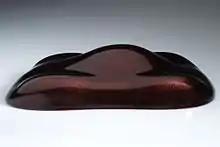Xirallic
Xirallic is an alumina effect pigment pigment made of aluminum oxide platelets covered with titanium oxide that shows a strong glitter effect with a distinct shimmering behavior.[1][2]

Car shape model varnished with an effect pigment based on an alumina substrate (Xirallic)
It was developed and patented by researchers of the company Merck KGaA in Japan.[3] Because the pigment was produced at a single plant in Onahama,[4] production was severally curtailed following the 2011 Tōhoku earthquake and tsunami.[5] The shortage of the pigment caused Ford and Chrysler to restrict the availability of cars and trucks in some red and black paints.[6] The shortage also affected other automobile makes. Hyundai replaced Xirallic with mica in their paints.[7] The plant reopened on 8 May 2011.[8]
See also
References
- Andrea Adelson (29 September 2000). "Next, a Kandy-Kolored Tangerine-Flake Color-Shifting Baby". New York Times.
- Phil Patton (13 June 2005). "Harvest Season for the '08 Car Colors". New York Times.
- Bennett, Jeff (11 March 2011). "Quake Spurs Supplier". Wall Street Journal.
- Neal E. Boudette, Jeff Bennett (March 26, 2011). "Pigment Shortage Hits Auto Makers". Wall Street Journal.
- Brett Davis (30 March 2011). "Xirallic paint shortage due to Japan earthquake". Car Advice.
- Peter Valdes-Dapena (28 March 2011). "Ford, Chrysler restrict colors for new cars". CNN Money.
- Deepa Seetharaman and Alina Selyukh (20 April 2011). "Hyundai finds solution for pigment shortage". Reuters.CS1 maint: uses authors parameter (link)
- "UPDATE 1-Quake-hit paint plant reopens in Japan". Reuters. May 10, 2011.
- Pfaff, G., Huber, A., “Spezielle Effektpigmente auf Basis von Aluminiumoxid-Plättchen”, Welt der Farben(2005)
- http://www.iol.co.za/business/international/closure-of-pigment-plant-limits-certain-colour-cars-1.1048481#.UCY2JJ3iaHc
- http://www.irishtimes.com/newspaper/innovation/2011/1125/1224307878356.html
External links
This article is issued from Wikipedia. The text is licensed under Creative Commons - Attribution - Sharealike. Additional terms may apply for the media files.